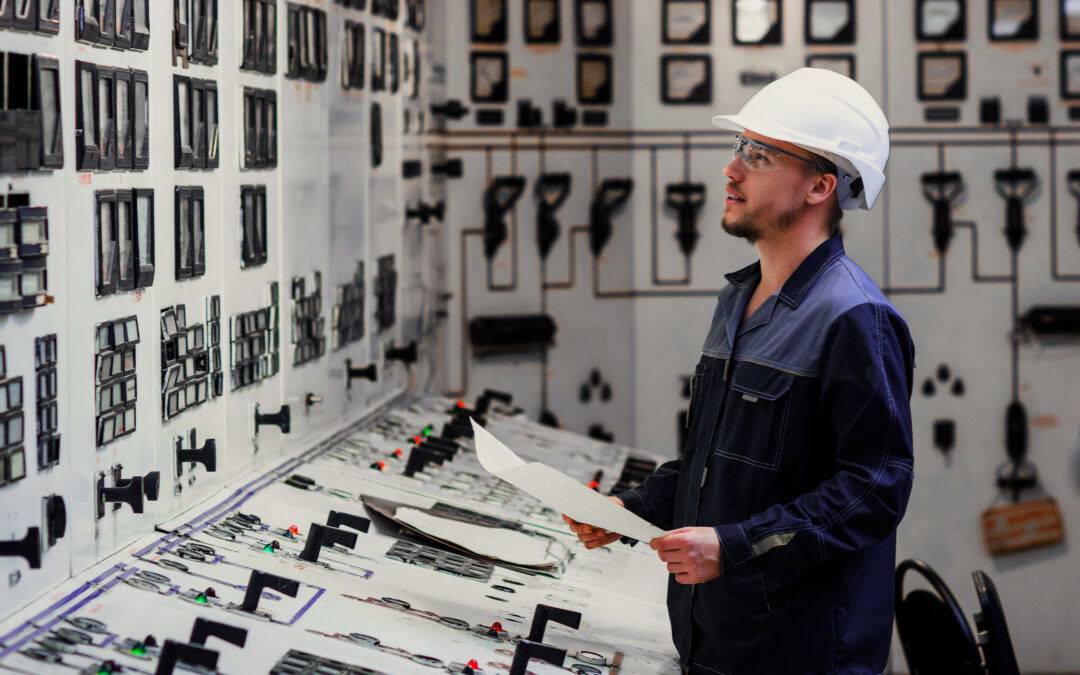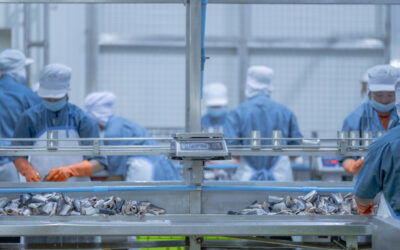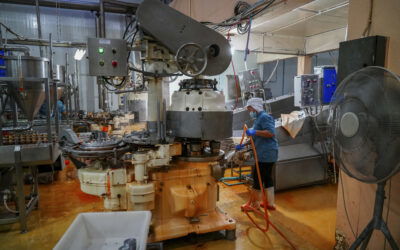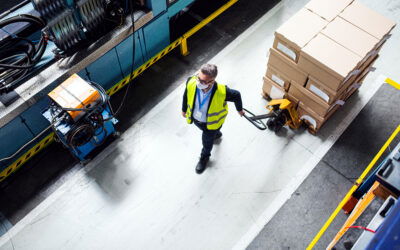TRS or OEE? What indicators should you use to measure your performance?
The OEE (Overall Equipment Effectiveness) and the TRS (Taux de Rendement Synthétique) now coexist in our French workshops. They are the benchmark for measuring machine performance. But what are the differences between the two? Do you have to change your calculation method to switch from one indicator to the other? Let’s find out together. When a plant is integrated into a group, for example, it is often necessary to change the indicators in question. Adapting them is not always easy, so we’re going to detail the steps involved in calculating them.
What is TRS?
The Synthetic Efficiency Ratio (SER) is a key indicator in the manufacturing sector that measures the efficiency of production equipment. In concrete terms, the SRR is calculated to assess the capacity of a machine or production line to generate products in line with expectations, in a given time and without interruption. This calculation takes into account three fundamental elements:
- Availability: Evaluates the actual machine operating time compared to the planned production time.
- Performance: Compares the current production rate with the optimum rate.
- Quality: Proportion of compliant products in relation to the total number of products manufactured.
In the manufacturing sector, TRS is essential because it enables production managers to detect inefficiencies and identify opportunities for improvement. By analysing losses in availability, performance and quality, companies can implement continuous improvement strategies to optimise the performance of their equipment.
What is the OEE?
Overall Equipment Effectiveness (OEE) is a universal metric used to measure the efficiency and quality of industrial production. Like TRS, OEE combines three key indicators to assess the overall performance of machines:
- Availability: Evaluates the actual machine operating time compared to the planned production time.
- Performance: Compares the current production rate with the optimum rate.
- Quality: Proportion of compliant products in relation to the total number of products manufactured.
OEE is particularly valued in industry because it provides an accurate picture of operational efficiency. It is often used to support strategic decisions, such as improving maintenance processes, increasing production capacity and improving product quality. Using OEE allows companies to benchmark against industry standards or past performance, making it easier to identify areas requiring urgent improvement.
Why implement a TRS?
The Synthetic Efficiency Ratio (SER) is vital for production managers and quality engineers in the manufacturing sector, offering crucial benefits for process optimisation and product quality:
Production Optimization: TRS identifies inefficiencies, enabling production cycles to be optimized, costs to be reduced and production capacity to be increased. Quality Improvement: This calculation integrates product quality, helping to quickly detect and correct manufacturing defects to maintain high quality Predictive Maintenance: TRS monitoring anticipates potential breakdowns, enabling preventive maintenance that reduces unplanned downtime and extends equipment life. Cost reduction: By eliminating waste and optimizing processes, TRS contributes to significant savings in materials, time and labor. Data-driven decisions: TRS data provides a solid basis for justifying investments and improving production methods, facilitating communication with stakeholders. Standards Compliance: TRS helps to meet industry and regulatory standards, satisfying quality and safety requirements.
How is the OEE calculated?
The prerequisites for measuring your OEE or your OEE are very similar. In fact, they are strictly identical. You will need standard production times for the products manufactured on your machine. You will also need the opening time of your workshop. This corresponds to the time during which the machines are likely to be running.
Everything else is done with a stopwatch. In both cases, you’ll have to keep track of the machine’s rate. With your PLC as orchestra conductor, you will measure the quantity of parts produced, the time during which the equipment is not producing, and you will count the good parts, as well as those scrapped.
How is the OEE calculated?
Calculating OEE (Overall Equipment Effectiveness) is an essential process for measuring the overall efficiency of equipment in the industrial sector. This indicator is crucial for identifying opportunities to improve machine performance. Here are the detailed steps for calculating OEE, using accurate production data:
Collection of necessary data :
1) To calculate the OEE, you need to gather the following information:
- Planned Production Time : The total time during which the machine should be operational.
- Planned and unplanned downtime: Includes breaks, planned maintenance and unplanned breakdowns.
- Actual Production Time: The actual time during which the machine has been running without interruption.
- Total Quantity Produced: The total number of units produced during the actual production time.
- Quantity of Compliant Products: The number of units meeting the quality criteria.
Calculation of the Three Main Components of the OEE :
2) The OEE is made up of three elements, which are calculated as follows:
- Availability: (Actual Production Time / Planned Production Time) x 100
- Performance: (Total Quantity Produced / Maximum Theoretical Quantity) x 100
- Quality: (Quantity of Compliant Products / Total Quantity Produced) x 100
Calculation of OEE :
The OEE is the product of the three components mentioned above, expressed as a percentage:
OEE = ((Availability × Performance × Quality) / 10000) × 100
3) This calculation gives you a percentage that reflects the overall efficiency of the equipment.
Interpretation of results
Today, there are some excellent solutions for measuring your TRS or OEE. The IoT (Internet of Things) makes it possible to connect machines of all ages. The possibilities are immense. Once calculated, your OEE will give you an overview of the state of production. The real benefit of a LEAN approach is to answer the following question: ‘What are the sources of my performance losses, and how can I deal with them?
Key differences between TRS and OEE
Since the question has been asked, here is the answer. The OEE and the TRS are strictly identical. One is the French version, the other the English version. So don’t panic, if you want to convert your TRS into an OEE, or vice versa, all you have to do is leave things as they are.
The French standard NF E-60-182 defines TRS. Published in 2002, it has not been revised since it was first published. It standardises the definitions of TRS and TRG (Taux de Rendement Global). The latter is translated as OOE (Overall Operations Effectiveness).
Thanks to this standard, it is possible to compare yourself with other similar workshops. However, there are a few limitations. These rules apply only to the manufacture of parts, and not to continuous operation. However, it is ‘easy’ to adapt it to measure the OEE of a continuous production machine.
Best practices for optimisation
Tips for improving TRS and OEE?
How do you measure up to the standard?
The standard is available on the AFNOR website. There is a lot of information from this standard on the Internet. This offers a significant number of alternative sources. Certain players have become essential. They allow us to measure ourselves, while focusing our vision on continuous improvement. TeepTrak has used the standard to create a real-time performance measurement system. You can find information from the official document here: AFNOR standards
The solutions offered by TeepTrak
Today, TeepTrak specialises in the creation and development of performance monitoring solutions. With a clear vision of the needs of continuous improvement, the above question is always answered.
PerfTrak is the dedicated solution for measuring TRS/OEE, TRG, or any other indicator you may wish to implement. Using a dedicated interface, the operator enters all the causes of stoppages. These are measured to the nearest second.
You can enter tomorrow’s world today. At a time when it is becoming increasingly difficult to compete with global industries, optimising machine performance is one of the solutions to consider.
The importance of corporate culture
Company culture is a key factor in the success of performance indicators such as OEE and TRS. A culture focused on continuous improvement and quality facilitates the adoption of these measures. Engaged and informed employees are more likely to participate in process optimisation. Open communication and welcoming suggestions for improvement lead to innovations that enhance overall performance.
Conclusion
TRS and OEE are vital for assessing and improving the efficiency of industrial operations. Their proper understanding and application enable precise adjustments to be made to increase productivity. In addition, a solid corporate culture that is consistent with these objectives is essential. It transforms the perception and use of these indicators, thereby strengthening the company’s competitiveness. To maximise their potential, it is crucial to maintain a culture that supports continuous learning and process optimisation.





0 Comments